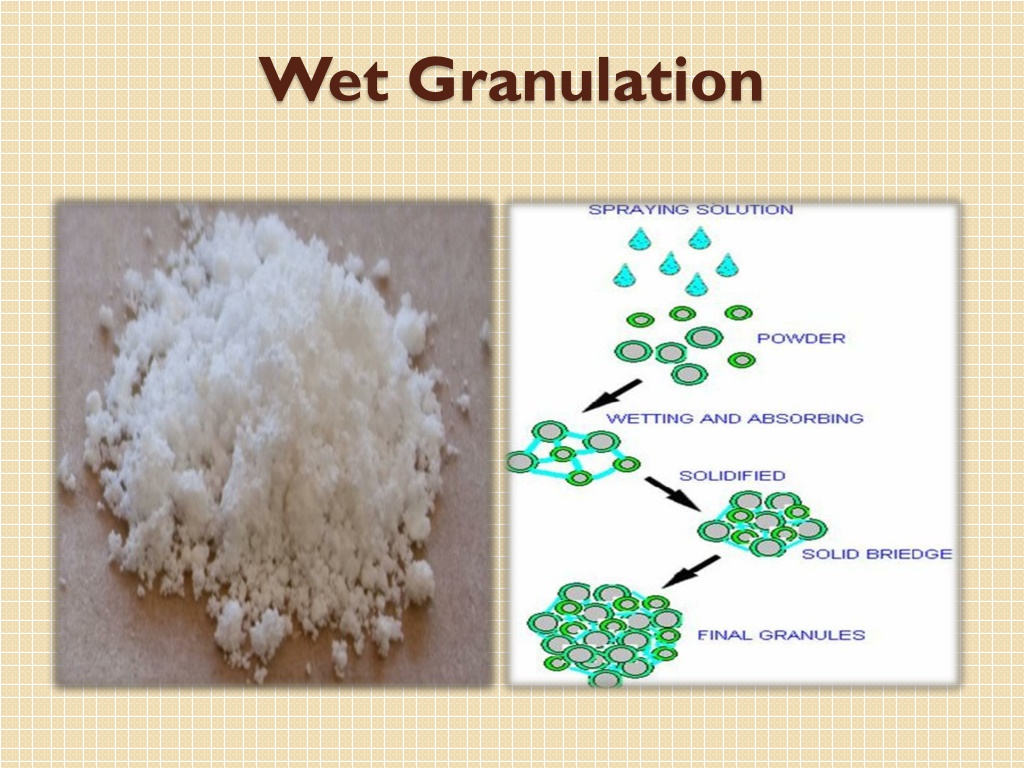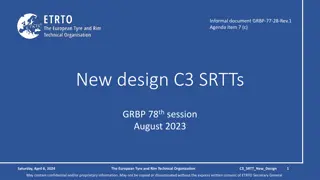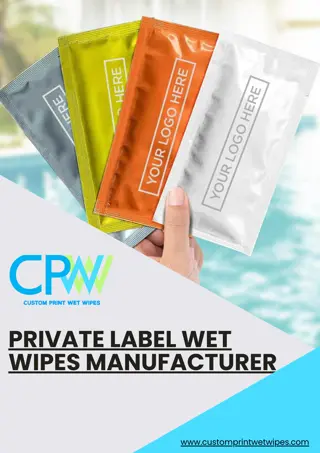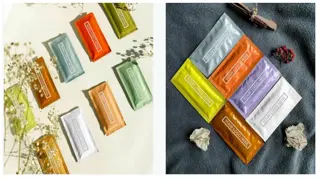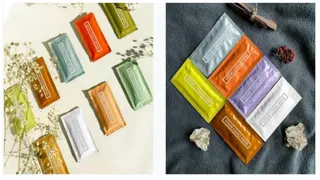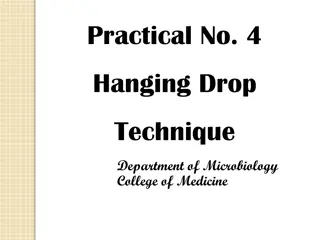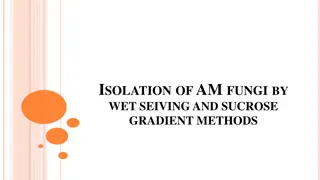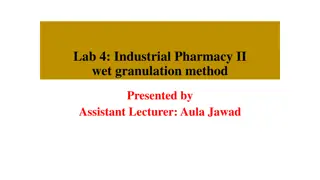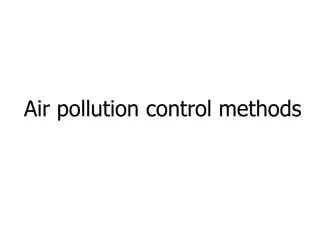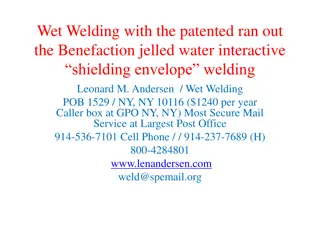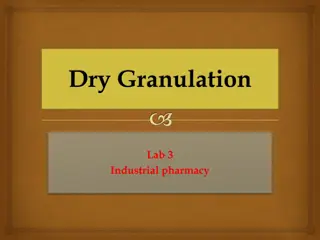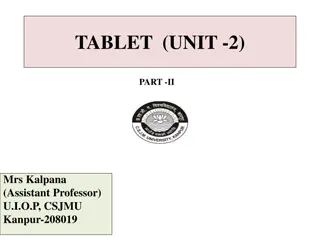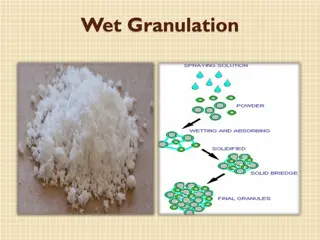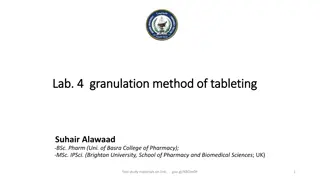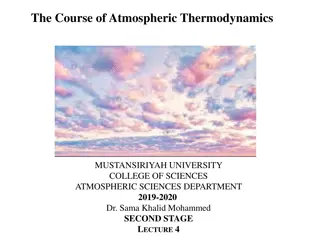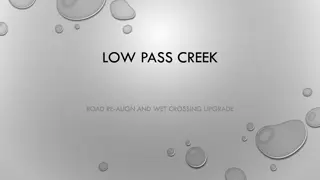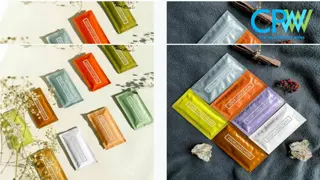Wet Granulation Technique Overview
Wet granulation is a pharmaceutical technique involving wet massing, wet screening, and drying in addition to the standard steps of direct compression. It includes mixing the drug, diluent, and disintegrant, wet massing with a binder, granulation through wet sieving, and drying. The process ensures uniform dispersion of ingredients and optimal tablet formulation for pharmaceutical production.
Download Presentation

Please find below an Image/Link to download the presentation.
The content on the website is provided AS IS for your information and personal use only. It may not be sold, licensed, or shared on other websites without obtaining consent from the author. Download presentation by click this link. If you encounter any issues during the download, it is possible that the publisher has removed the file from their server.
E N D
Presentation Transcript
Wet Granulation The wet granulation technique uses the same preparatory and finishing steps of direct compression and dry screening and mixing); it also involve additional steps of wet massing, wet screening and drying. granulation (dry
Steps of Wet Granulation 1.Mixing (blending) of the drug, diluent and disintegrant. 2.Wet massing by addition of binder or adhesive or called granulation agent. 6.Mixing (blending) by addition of glidant and lubricant. 5.Homogenizing by second sieving (dry screening). 3.Granulation by sieving (wet screening). 4.Drying.
Wet Massing Mixing Wet Drying Screening Dry Mixing Screening
1- Mixing Mixing starts with adding drug then excipients. The mixing process depends on the properties of the drug and excipients. If the drug is soluble in water and excipients are little; so we start to add binder solution to the drug to be distributed uniformly then excipients that have little solubility in water (e.g. starch), it is possible to be added extragranularly [as a whole] or [divided and added as one half intragranulary and the other extragranulary to avoid getting friable tablets]. Total amount of disintegrant is not always added completely to the powder diluent (intragranulary), some other portion might be added with lubricants (extragranulary) in the final step prior to compression disintegration) mixture (double
2-Wet Massing Adhesive (binder) is most commonly employed as solution,suspension,slurry,or used as a dry powder. Method of introducing the binder depends on its solubility and on the components of the mixture (wettability). In the wet massing step the binder solution will distribute and filling the spaces between particles. The primary force of granulation act as a bridge and is obtained from capillary force or pressure of the liquid (binder solution) between particles. surface tension and
Once the liquid is added, mixing is continued until we get a uniform dispersion of the adhesive within the whole system. The length off wetting time depends on the wetting property of the powder mix. and the granulating fluid, efficiency of the mixer. and on the The end point can be determined by the press mass test (ball test) as the mass must be moisten rather than pasty or wet, it is done by pressing a portion of the mass in the palm if the ball moderate pressure, the mixture is ready for the next step (wet screening). crumbles under a
Over wetting causes: 1.Hard aggregates of powder during milling process. 2. Some of the material may block the sieve or screen(sticky). 3.Slow drying process. Note: If the material to be granulated is water sensitive a great care should be considered by the use of organic solvents (e.g PVP in isopropyl alcohol as a binder) because it is flammable, expensive, not easily handled.
3-Wet Screening (granulation) Granulation is performed to obtain a discrete granules consolidate the granules by increasing the particles contact points, and also to increase surface area to facilitate the drying process. and further 4- Drying After drying step the granules should contain some degree of humidity to act as a binder (not be 100% free of humidity) as over drying may leads to weak force and friable granules.
The final cohesive force obtained after drying stage when evaporation of solvent occur as a result recrystalization and curing of the binding agent with Van der Waals forces playing a significant role. of fusion,
5- Dry screening After performed granules with uniform size and shape. drying; then to dry screening homogenized is get a 6- Mixing By addition of lubricants and glidants. Therefore, the granules will posses good compressibility (good cohesive forces once applying punch forming solid impact tab.), good flowability (spherical shape that is the ideal physical form in providing smoothness and size uniformity to the particles which is easily flow).
Advantages of wet granulation method: 1.Improve compressibility of the powder, so the powder is easily compressed with lower binder concentration (due to the stick of powder particles together that are surrounded by layer of a binder) in addition to the low pressure and low energy granulation (prolong machine age). flowability, cohesiveness and comparing to dry 2. Can be used for high dose drug with weak compressibility that is not affected by heat and moisture. 3. Maintaining uniform distribution for low dose drug and water soluble dyes (coloring agent).
4.Improve the dissolution rate of hydrophobic drug because of the presence of moisture already used water. of the 5. uniformity due to prevention of particle segregation since all the granules will have the same density (same constituent of the powder mixture). Maintaining good content
Disadvantages of wet granulation method 1.cost-time consumer 2. Personal and environmental hazards upon using organic solvents represented by the flammability and toxicity of these solvents after evaporation during drying,handling or storage. 3. Stability problem because of the presence of moisture speeds up the reaction between active ingredients and the additives and the additives itself.
Preparation of Sulfadiazine (sulfa drug) by wet granulation Organoleptic properties: White crystalline or white yellowish fine crystals or powder form, tasteless or slightly bitter taste. Solubility: Practically chloroform, and ether; very slightly soluble in ethanol; soluble 1 in 300 of acetone; soluble in dilute mineral acids and in solutions of alkali hydroxides and carbonates. Absorption: it is weak acid (pKa=6.36), so they are well absorbed from GIT, mainly in stomach because are present in undissociated form. insoluble in water,
Stability: Stable in dry air and not affected by moisture and heat, slowly darken and decompose, protected from light should be kept in dark closed container (opaque containers). so should be Sulfadiazine is prepared by wet granulation method for the following reasons: 1.They are not affected by moisture and heat. 2.Large doses 3.Present in powder form as fine crystals.
Sulfa drug are not prepared by direct compression because: 2.They are used in large doses and direct compression is only used for intermediate doses. 1.They had bad flowability because they present as fine powder or fine crystals
Example Sulfadiazine Ca carbonate Explotab Zn stearate Acacia mucilage 20%(w/v) q.s. 500 mg (active ingredient) 250 mg (diluent) 50 mg (disintegrant) 10 mg (lubricant) (binder) prepare 50 tablets
Answer Mix all ingredients except lubricant and binder. Add the binder drop by drop (ball test). Calculate the weight of acacia in each tablet (If we use for example 5 ml of (20%w/v) acacia mucilage for 50 tab.) 20 gm x 5ml = 1 gm of acacia for 50 tab 1gm/50 *1000= 20 mg of acacia per tab. 100 ml
Calculate the theoretical wt. of one tablet (without lubricant) 500 mg+250 mg+50 mg+20 mg =820 mg wt.of one tablet without lubricant Weigh the prepared granules (actual wt. of tablets without lubricant) for example it was found to be 33200 mg Find the real no.of tablets Real no.of tab.= actual wt./theoretical wt. =33200 / 820 =40.4 tablets
Calculate the actual amount of lubricant to be added: amount of lubricant =10 mg * Real no.of tab. =10 * 40 =400mg of lubricant added
Question Na2CO3 Lactose 100mg Starch 10mg Acacia mucilage Zn stearate 0.5mg 125mg 20%(w/v)q.s. Prepare 20 tablet
